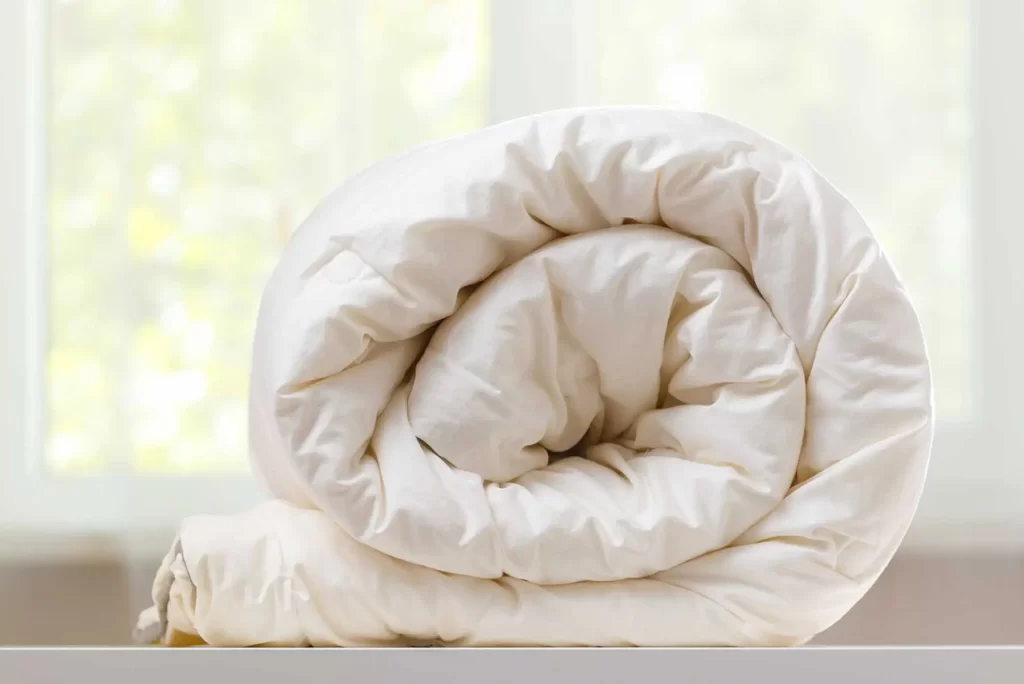How to Wash a Duvet – The Easy Way!
Do you have a duvet that needs to be washed but needs to know how to wash a duvet? In this blog post, we’ll walk you through the easy process of how to wash a duvet so you can get it clean and fresh in no time.
As we are writing an informative write-up, there might be readers who will know for the first time about a duvet. For them to understand the duvet, let’s start with an introduction.

What Is a Duvet?
It is a fluffy, quilted blanket generally used as a top layer on your bed. It’s usually filled with feathers, wool or synthetic materials. It’s a popular alternative to blankets and comforters because it’s lighter, fluffier and easier to keep clean.
A cover is placed over it to protect it and add a layer of warmth. There are many types to choose from depending on what kind of look you’re going for and your home’s climate.
Depending on the season and region, duvets may also be considered continental quilts, sleeping bags, comforters, or eiderdowns. These can be machine washed but must follow a few essential steps.
How to Wash a Duvet : Step-by-Step Guide
With the proper steps, washing a duvet isn’t as difficult as it seems! Pre-treat any stains according to the care label. Once finished, you can put the item in your washing machine with detergent.
Although it may be difficult, we will explain all of the necessary steps one at a time.
Check the Care Label First
It’s essential to check the care label before washing. This will explain the recommended cleaning method, temperature, cycle type, and detergent instructions.
To avoid damage to your duvet, be sure to follow these instructions. Use the gentlest cycle and cold water if the care label is missing or unreadable.
Pre-Treat Stains
Here are the steps to follow:
By taking the time to pre-treat your duvet, you will be helping to ensure your bedding looks as good as new!
Put Your Duvet in the Washing Machine
Once you’ve spread it out in the washing machine, you can begin to close the lid and start the cycle. Before you do this, check the settings on your machine and ensure it’s on a delicate cycle with cold water. Most duvets need a delicate cycle because they are lightweight, and cold water will help protect the colours and material from fading or shrinking.
Be aware of the capacity of your washer as well. If your stuff is more significant than what your washer can hold, take it to a laundromat with a larger washer. You’ll also want to ensure a load is manageable for your machine, as an overloaded washer can cause damage.
Add Detergent
Too much detergent can make your fabrication feel stiff and cause it to lose its softness over time. Too little, however, can leave your duvet with soapy residue and cause it to look dingy.
To ensure that it gets the perfect clean, measure out half of the recommended amount of detergent for a regular load of laundry and add it to the machine’s detergent dispenser.
Do not use liquid fabric softener or bleach when washing your duvet; these products can damage the fabric or cause fading. If you need more detergent information, refer to your duvet’s care label.
Wash on a Delicate Cycle
When you choose the delicate cycle, use cold water and mild laundry detergent. This will help protect the fabric while getting it clean. If your washer has a low-spin cycle, select that setting.
For best results, wash only two or three duvets at a time, ensuring the washer is manageable. Doing so will also help keep the fabrics from bunching up or twisting in the washer.
Check for Soap Residue
After the duvet is finished in the washing machine, it’s essential to check for any soap residue. This can be done by feeling the fabric and running your hand along the seams and edges. If there is a soapy feeling or a clump of detergent, it’s a sign that there is still soap residue. To eliminate this:
Rinse in cold water until the soap is gone.
Hang Your Duvet Outside to Dry
Once the washing cycle is finished, you must take your duvet out of the washing machine and hang it outside in the sun. Make sure you secure all four corners of the line with clothespins. Do not fold it.
Shake the material gently every few hours while drying to promote air circulation. This will also help reduce drying time and ensure the filling stays evenly distributed. Once it is scorched, shake it out again and fluff up any clumps of filling before storing or using it again.
If you don’t have a place to hang it outside, you can also lay it flat to dry on a clean surface indoors.
How Frequently Should I Wash My Duvet?

It is advisable to wash your duvet every six months. This ensures it remains hygienic and free of dust mites or other allergens. You may need to wash more often if you have pets or a higher incidence of dust or allergies.
Depending on the type of fabric, some duvets can be spot-cleaned instead of thoroughly washed. If you decide to spot-clean, be sure to spot-test an area first to ensure no damage occurs to the fabric.
Ultimately, it is up to you how often you wash your duvet; just be sure to use the proper instructions and materials to keep it looking its best.
Tips for Storing a Duvet After Washing and Drying

Storing your duvet is as essential as washing it, as it can affect longevity. Here are some tips to help you store it in the best possible way:







